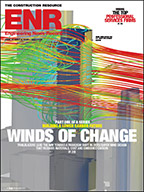In January, the council began an $87,800 study to compare technologies used in Korea for the production of supertall buildings with technologies in other nations. Areas under scrutiny include project management, engineering, materials and disaster risk reduction. The one-year study is funded by the Korean Institute of Construction and Transportation Technology Evaluation and Planning through a contract with the Research Institute of Industrial Science & Technology. David Scott, a principal of Arup New York, New York City, is the principal investigator.
CTBUH's outrigger guide will be a first. In Seoul, Hi Sun Choi, a Thornton Tomasetti senior principal, said that while outriggers have been used to stabilize skyscrapers since the 1980s, there has never been a how-to publication.
Ahmad K. Abdelrazaq, executive vice president of Samsung C&T Corp., Seoul, is leading the charge on the column-shortening guide. Based in part on Samsung's monitoring of the Burj Khalifa, the publication will incorporate case studies, materials advances, analysis, monitoring and building methods.
A draft for the wind- tunnel testing guide is available for comment, said Peter A. Irwin, chairman of wind engineer Rowan Williams Davies & Irwin Inc., Guelph, Ontario, Canada. Beyond creating a greater familiarity with wind testing in the general design community, the guide will offer standard formats for presenting test results. The aim is to ease the process of comparing information from different test laboratories and to identify causes for the differences, said Irwin.
The CTBUH guide for performance-based seismic design will extend the U.S.-centric Seismic Design Guidelines for Tall Buildings, released this year by the Pacific Earthquake Engineering Research Center, to a global audience, said Ron Klemencic, president of structural engineer Magnusson Klemencic Associates, Seattle. Currently, North America, Chile, the Philippines, Indonesia, China and Japan have different practices, standards and codes for seismic design. The goal is to standardize practice globally.
The CTBUH foundations guide will also offer steps for performance-based design, taking into account soil and structure interaction, rather than limiting engineers to traditional, empirically based design methods, said Sungho Kim, president of Jinyoung Engineering & Consultants Co. Ltd., Seoul.
The CTBUH guideline on natural ventilation in tall office towers will also evaluate case studies and put forth a set of best practices, said Wood, who is leading the effort. The goal is to encourage a reduction in building energy use.
At the conference, the 2009-11 chairman of the council, Sang Dae Kim, a professor in the Dept. of Civil, Environmental and Architectural Engineering at Korea University, Seoul, passed the gavel to the 2011-13 chairman, Timothy Johnson, a design partner in the New York City office of architect NBBJ. Johnson, a self-described tall-buildings junkie, is the first architect to chair the CTBUH.










Post a comment to this article
Report Abusive Comment